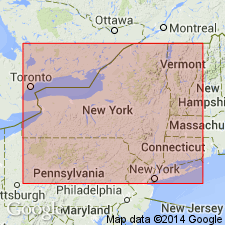
- Usage in publication:
-
- Canaseraga sandstone
- Modifications:
-
- Areal extent
- AAPG geologic province:
-
- Appalachian basin
Summary:
Pg. 69. [Shown (in table) as underlying Gowanda, overlying Wiscoy shale, as = Dunkirk shale, and of basal Chemung age.]
Source: US geologic names lexicon (USGS Bull. 896, p. 330-331).
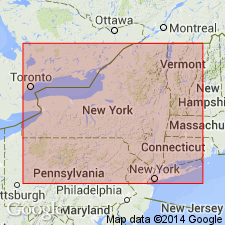
- Usage in publication:
-
- Canaseraga sandstone
- Modifications:
-
- Principal reference
- Biostratigraphic dating
- Dominant lithology:
-
- Sandstone
- AAPG geologic province:
-
- Appalachian basin
Summary:
Pg. 150. Canaseraga sandstone. East of the Genesee [River], above Dalton and Swains, the increase in sand is so rapid that in Slader Creek, [south of Canaseraga, Canaseraga 7.5-min quadrangle, Allegany County, western New York], only two thin courses of black shale remain in lower part of 150 feet of heavy arenaceous beds with full Chemung fauna that we propose to call Canaseraga sandstone. Massive character of the Canaseraga has lead to its confusion with the Nunda at some points to east, under name Highpoint. It is believed that the Dunkirk-Canaseraga corresponds in horizon with DALMANELLA DANBYI zone at base of Cayuta shale in Ithaca region. [Age is Late Devonian.]
Source: US geologic names lexicon (USGS Bull. 896, p. 330-331).
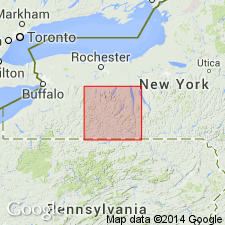
- Usage in publication:
-
- Canaseraga sandstone†
- Modifications:
-
- Abandoned
- AAPG geologic province:
-
- Appalachian basin
Summary:
In this report, Dunkirk sandstone replaces rocks called Canaseraga sandstone by Chadwick (1924). Later, Chadwick found the Canaseraga to be a sandy facies of the Dunkirk and recommended dropping the term. The name is herein abandoned.
Source: GNU records (USGS DDS-6; Reston GNULEX).
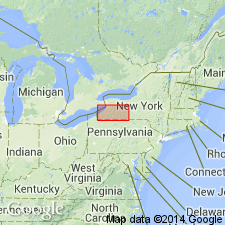
- Usage in publication:
-
- Canaseraga sandstone member*
- Modifications:
-
- Reinstated
- Principal reference
- Dominant lithology:
-
- Sandstone
- Siltstone
- Shale
- AAPG geologic province:
-
- Appalachian basin
Summary:
Canaseraga sandstone member of Perrysburg formation. Revived and redefined as sandstone member of Perrysburg formation (new). These siltstones and sandstones are a definite unit around Canaseraga in central part of State and are not represented in rock sequence in vicinity of Dunkirk in western New York. At type exposure, member consists mainly of thin-bedded to massively bedded siltstones and some interbedded silty gray shale containing a few thin layers of black shale near base; top not exposed. Toward the west in Genesee River valley, upper siltstone of Canaseraga thins and grades laterally into black, dark-gray, and blackish-gray shale of Hume member (new). East of Dalton, upper part of member becomes more massive as siltstone increases in thickness and interbedded shale decreases. In Bath and Woodhull quadrangles, underlies Canisteo member (new); underlies and interfingers with South Wales member (new) to west. Thickness 163 to about 308 feet. [Age is Late Devonian.]
Type exposure: on Slader Creek, south of Canaseraga, [Canaseraga 7.5-min quadrangle], Allegany Co., western NY.
Source: US geologic names lexicon (USGS Bull. 1200, p. 603).
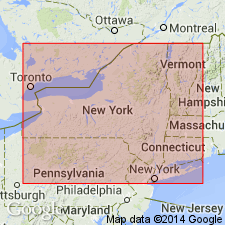
- Usage in publication:
-
- Canaseraga member
- Modifications:
-
- Areal extent
- AAPG geologic province:
-
- Appalachian basin
Summary:
Pg. 10 (fig. 1), 12. Canaseraga member of Canadaway formation. Overlies South Wales member; underlies Hume member. [Age is Late Devonian.]
Source: US geologic names lexicon (USGS Bull. 1200, p. 603).
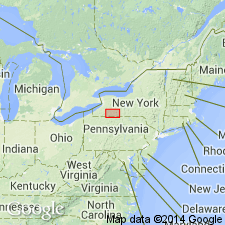
- Usage in publication:
-
- Canaseraga formation
- Modifications:
-
- Revised
- AAPG geologic province:
-
- Appalachian basin
Summary:
Pg. 17 (table 2), 18. Canaseraga formation of Canadaway group. [Age is Late Devonian.]
Source: US geologic names lexicon (USGS Bull. 1200, p. 603).
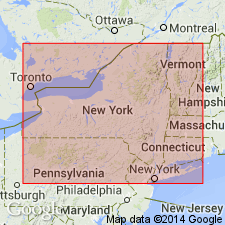
- Usage in publication:
-
- [Canaseraga Sandstone Member]
- Modifications:
-
- Not used
- AAPG geologic province:
-
- Appalachian basin
Summary:
Pg. 7. The Canaseraga and Canisteo of Pepper and de Witt (1951) = Wiscoy, and therefore are superfluous.
Source: Publication.
For more information, please contact Nancy Stamm, Geologic Names Committee Secretary.
Asterisk (*) indicates published by U.S. Geological Survey authors.
"No current usage" (†) implies that a name has been abandoned or has fallen into disuse. Former usage and, if known, replacement name given in parentheses ( ).
Slash (/) indicates name conflicts with nomenclatural guidelines (CSN, 1933; ACSN, 1961, 1970; NACSN, 1983, 2005, 2021). May be explained within brackets ([ ]).

